X-RAY RUNS: Apply for Beamtime
2017 Nov 1 - Dec 21
2018 Feb 7 - Apr 3
2018 Proposal/BTR deadline: 12/1/17
2018 Apr 11 - Jun 4
2018 Proposal/BTR deadline: 2/1/18
__________________________________________________
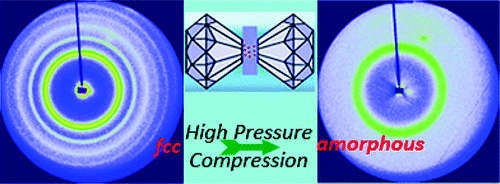
High-Pressure Studies Uncover Ways to Make Valuable Technological Materials
New materials with surprising and sometimes useful new properties are often found by modifying the structures of known materials without altering their composition. One approach is to subject materials to very high pressures of up to 100 GPa (100GPa = 1,000,000 times atmosphere pressure). The classic example is graphite, a soft and opaque material with a loose layered structure, which can be turned into ultra-hard, transparent diamond, a crystal with cubic symmetry.
Full article here: http://news.chess.cornell.edu/articles/2011/CompareWang.html
__________________________________________________

It Only Takes a Drop: Programmable nanoparticle monolayers at the air-solution interface
DNA, the carrier of the genetic information, is a negatively charged macromolecule. For 2 DNA strands to be able to bind, positive counterions have to be added to the aqueous medium in form of salt, to screen the repulsive Coulomb force. Moreover, the salt concentration also determines whether the DNA strands are rather straight (low salt content) or coiled up (high salt content), as uncharged polymers typically are. If DNA strands are anchored on a nanoparticle, the height of the resulting DNA corona and thus the nanoparticle-nanoparticle distance can be controlled by the concentration of counterions.
Full article here: http://news.chess.cornell.edu/articles/2011/DropSmilgies.html
__________________________________________________
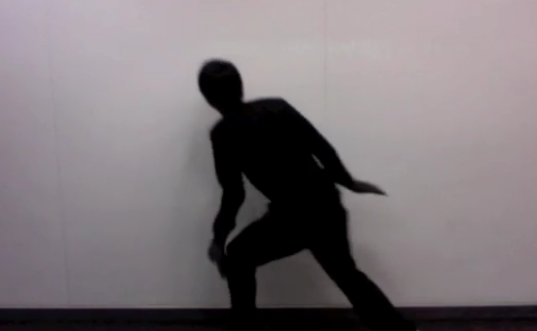
CHESS User Dances his Ph.D.
Cornell graduate student FoSheng Hsu has won the chemistry division of Science magazine's 2011 'Dance Your Ph.D.' contest. Hsu received a $500 prize for his entry.
Hsu's video, The Holy Grail to X-ray crystal structure of human protein phosphatase can be viewed at Vimeo (03:15) and also at CornellCast. The video consists of several distinct segments each representing a different step in crystallography: protein expression, affinity purification, crystallization, X-ray diffraction and solution of the structure. Each segment features a different dance style and sound track. Hsu wrote, directed and performed all dancing roles in the video, with technical assistance from fellow students Pi-Chang Hsu and Ching-Lin Hsieh.
Entrants must have, or be working on a Ph.D. in a science-related field, and must be a part of the dance they submit. 55 entries were submitted this year. Prizes were also awarded for physics, biology and social sciences, along with a grand prize, which went to physics winner Joel Miller.
Dancing is an aside to FoSheng Hsu’s important work in biomedical science. He works on the structural biology of proteins involved in the regulation of membrane trafficking in the laboratory of Yuxin Mao of Cornell's Weill Institute for Cell and Molecular Biology. Hsu collects diffraction data from his crystals at the CHESS beamline A1.
Submitted by: David J. Schuller, MacCHESS, Cornell University
__________________________________________________
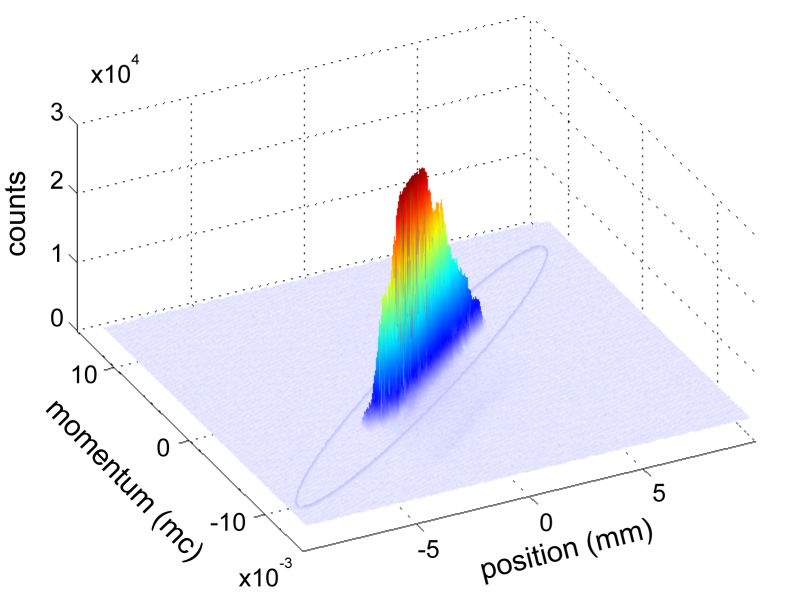
Measured transverse phase space of the ERL injector
beam at 80pC/bunch charge.
Cornell Surpasses Milestones Towards New ERL Coherent X-ray Source
Synchrotron x-ray sources have become essential tools across the sciences, medicine, and engineering. To continue the rapid pace of advances in these fields, researchers need much better high-intensity, short wavelength x-ray sources to capture ultra-fast phenomena and probe materials with atomic resolution. Existing continuous duty synchrotrons fall short because they produce mostly incoherent light. Because of this limitation, there is a world-wide race to build coherent, high-flux hard x-ray sources. The National Science Foundation (NSF) has been supporting R&D at Cornell University to innovate, design and prototype superconducting Energy Recovery Linac (ERL) technology as a basis for a next generation source (see erl.chess.cornell.edu).
Full article here: http://news.chess.cornell.edu/articles/2011/CoherentOct2011.html
Cornell Chronicle Online News:
http://www.news.cornell.edu/stories/Oct11/erlUpdate.html
or (pdf)
__________________________________________________

Cornell's 7-cell
superconducting RF cavity.
Cornell-ERL Main-Linac Cavity Reaches Performance Specs in Vertical Test
Cornell has reached performance specifications for the ERL's main-linac cavities in a vertical test. This cavity has been completely designed, constructed, and tested in Cornell's SRF group. The cavity shape has been optimized to allow 200mA in the ERL linac, even with realistic construction errors. Starting with bare niobium sheets, the SRF team constructed this cavity from scratch, carefully controlling dimensions along the way. This led to a field flatness of 85% without tuning, an exceedingly high number indicating exceptional production accuracy. Chemical cleaning has also been performed in house.
Full article here: http://news.chess.cornell.edu/articles/2011/7cell.html
More SRF News:
http://www.lepp.cornell.edu/Research/AP/SRF/WebHome.html
__________________________________________________
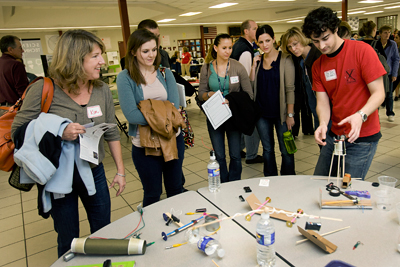
Sam Posen demonstrates a simple motor for local teachers.
(Credit: Jason Koski/University Photography)
Hands-on Science Learning for Local School Teachers
While students in the Ithaca City School District (ICSD) enjoyed a day off Oct. 7, their teachers were learning how to use Cornell resources to enhance their teaching. They learned, for example, how to create simple experiments using electricity, magnetism and polymers and to take advantage of free hands-on activities, learning kits, lesson plans and staff visits from Cornell in their classrooms.
Read more from Nancy Doolittle's article in Cornell Chronicle:
http://www.news.cornell.edu/stories/Oct11/ResourceFair.html or the (PDF)
__________________________________________________
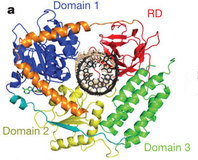
Structural Basis of RNA Recognition
Human cells have methods to distinguish their own RNA from the RNA of invading viruses. One of those methods involves retinoic acid-inducible gene-I (RIG-I)(also known as DDX58), one of the receptors of the innate immune system in our body: the 2011 Nobel prize is awarded to scientists for their discovery of the innate immune defense systems. RIG-I is a helicase that recognizes and is activated by a number of features which are common to many viral RNAs but not to normal cellular RNA. Once it is activated, it turns on the innate immune response that establishes an anti-viral defense system in the cell. A better understanding of the function of RIG-I could lead to better anti-viral therapies as well as treatments for the consequences when the RIG-I system goes wrong, which can include cancer and auto-immune diseases.
Complete article:
http://news.chess.cornell.edu/articles/2011/SchullerRNA10052011.html
__________________________________________________
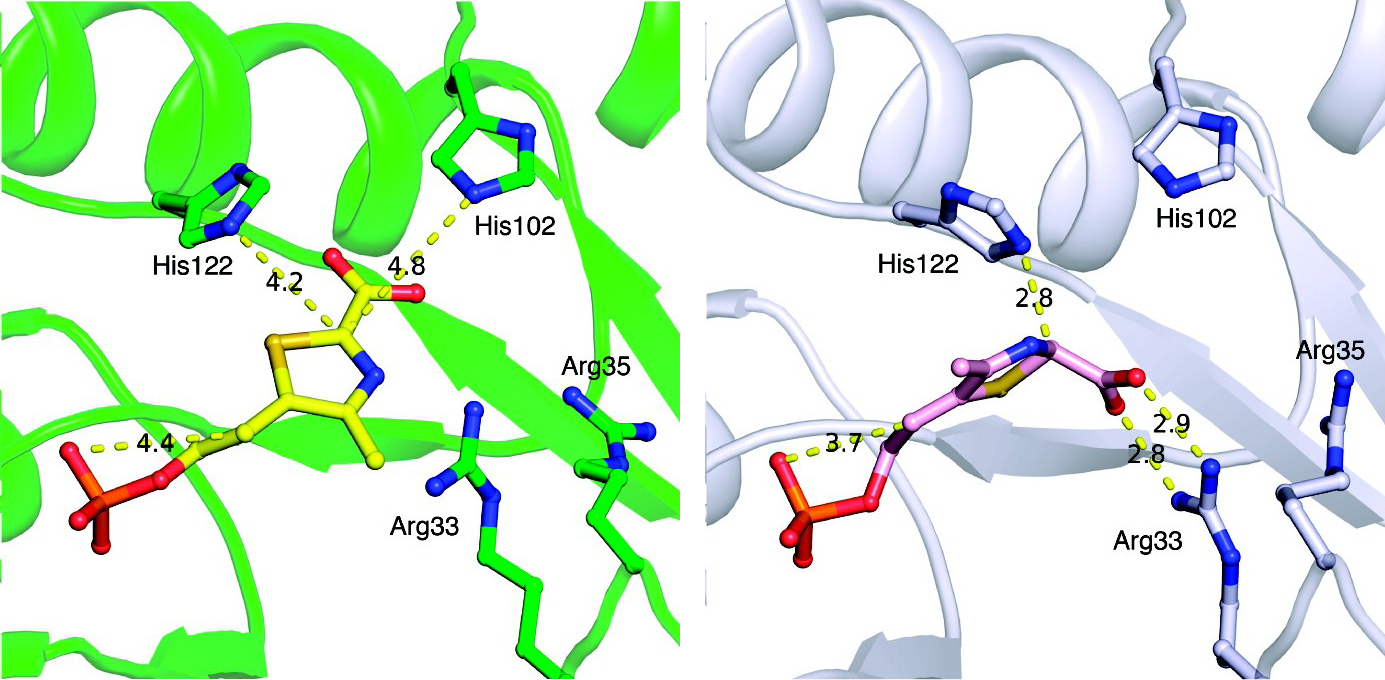
Thiamin Pathway Completed
Thiamin (British spelling thiamine) is an important cofactor in many enzymatic reactions. Humans do not synthesize their own thiamin, which is why it is characterized as vitamin B1, an essential part of our diet. Most of the biochemical steps in the synthesis of thiamin by bacteria and plants are known, along with the enzymes that catalyze them. Although the protein TenI has been thought to be part of the thiamin pathway because it tends to cluster with other genes for thiamin synthesis and shares sequence similarity to some of them, a specific role in the pathway for TenI had never been identified.
Complete article:
http://news.chess.cornell.edu/articles/2011/Thiamin.html
__________________________________________________
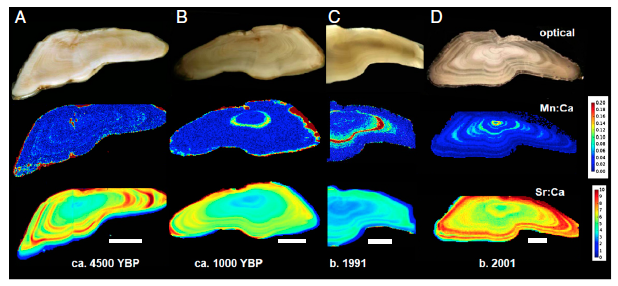
Researchers Track Exposure to Environmental Dead Zones, Spanning Millennia
Hypoxia refers to a pathological condition where an organism is deprived of an adequate supply of oxygen; anoxia refers to complete deprivation of oxygen. These terms are also used to describe regions of coastal environments with low concentrations of dissolved oxygen, which impacts fish habitat, in some cases so severely that these regions are colloquially known as "dead zones". Researchers are interested in studying how the migration habits of fish are effected by historical trends in hypoxia.
Complete article:
http://news.chess.cornell.edu/articles/2011/Dale09072011.html
__________________________________________________
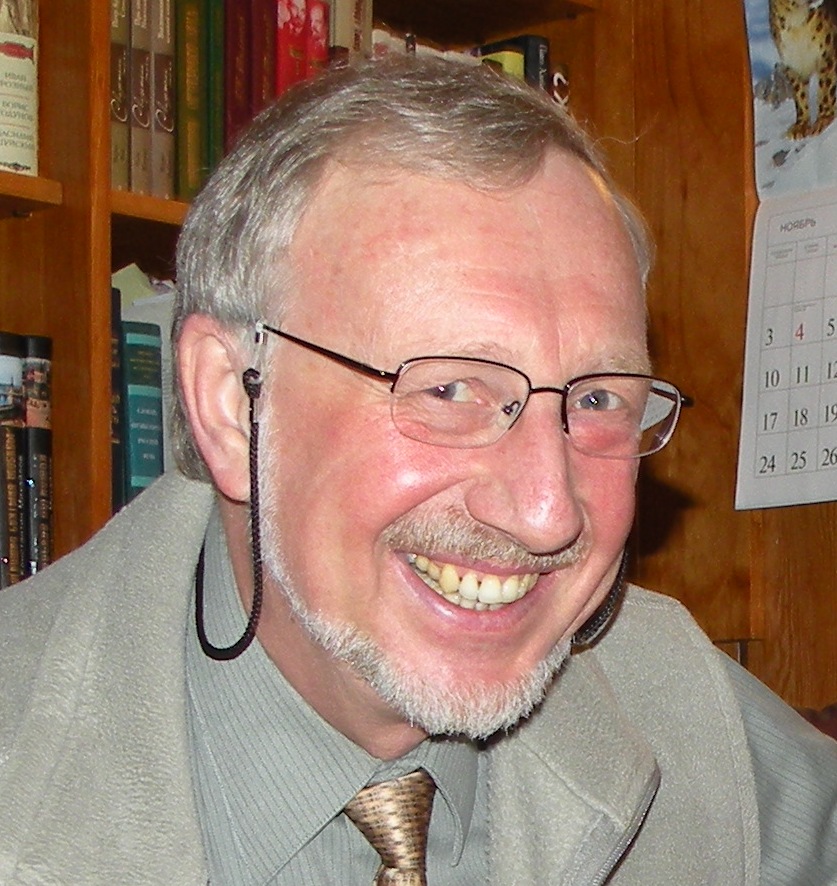
To the Memory of Dr. Alexander Kazimirov (1952 - 2011)
It is with great sadness that we report the loss of CHESS staff scientist Dr. Alexander Kazimirov. Alex will be remembered as dedicated x-ray scientist, an inspiring graduate student mentor, and an innovative and accomplished x-ray optics expert. He was a regular participant in, and helped organize, numerous conference workshops and special sessions, and a tribute similar to the following was written to honor him in the proceedings of the 2011 SPIE conference, to which Alex was planning to be a contributor, which is being held the week of August 22-26.
Complete article:
http://news.chess.cornell.edu/articles/2011/AKazimirovIMO.html
__________________________________________________
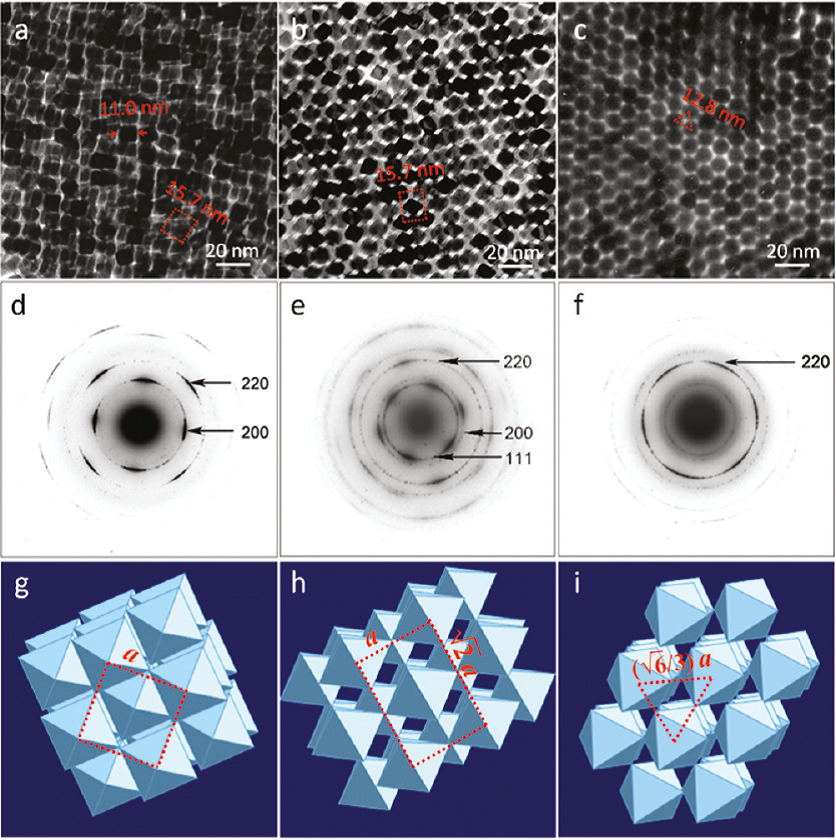
Octahedral Nanoparticles Pack with a Lot of Space in Between
Nanoparticles are nm-sized particles of metals, semiconductors, and insulators surrounded by a shell of organic molecules bound to the surface of the inorganic cores. These organic molecules allow the nanoparticles to be dispersed in liquids, which in turn, facilitates crystallization of the particles into superlattices. Such nanoparticle superlattices constitute a class of synthetic materials with novel optical, chemical, electronic, and magnetic properties.
Complete article:
http://news.chess.cornell.edu/articles/2011/OctahedralNanoparticles.html
__________________________________________________

Tools for growing, manipulating, mounting crystals
Professor Rob Thorne, Cornell Physics Dept., is actively developing tools and techniques for protein crystallography, as well as studying the physical processes occurring in crystals exposed to X-rays and/or subjected to changes in temperature. A recent area of focus is the growth of protein crystals. A common, well-developed, technique for this purpose involves the diffusion of solvent vapor, usually water, between a drop of solution containing protein and a "reservoir" solution of different composition, e.g. higher in a precipitant concentration. The plates commonly used for vapor diffusion have some deficiencies, particularly when used in a high-throughput operation where it is desired to evaluate crystals in situ rather than putting effort into extracting putative crystals, many of which will turn out to be useless. A recent publication from the Thorne group addresses this problem.
Complete article:
http://news.chess.cornell.edu/articles/2011/ThorneTools.html
__________________________________________________
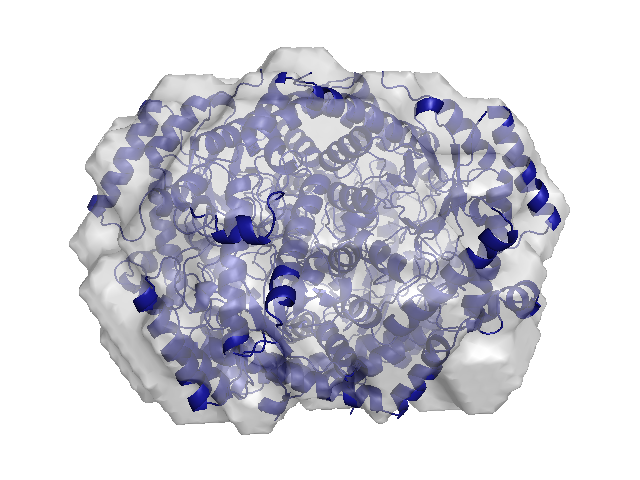
BioSAXS Minicourses
This past March MacCHESS offered an introductory minicourse, BioSAXS Essentials, designed to cover the basics of small-angle-x-ray solution scattering from biological solutions. Demand for the minicourse immediately exceeded expectations, so the course was repeated in May with a class size twice that of the March offering.
Complete article:
http://news.chess.cornell.edu/articles/2011/BioSAXSmini.html
__________________________________________________
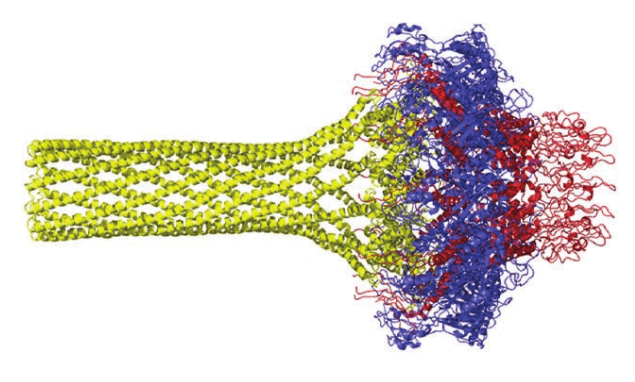
DNA Packaging and Ejection by P22 Bacteriophage - function of the portal complex
Bacteriophages are viruses which infect bacteria. Many of them consist of a rigid icosahedral capsid containing the phage's genetic material attached to a tail which penetrates the bacterial wall during the infection process. A complex structure known as the "portal" connects the tail and the capsid, and is required both to load the capsid with DNA (or RNA) and to mediate its injection into the host bacterium.
Complete article:
http://news.chess.cornell.edu/articles/2011/CingolaniP22.html
__________________________________________________

(photo: courtesy of the Sciencenter)
NanoDay 2011 - See Your World in a Different Light
During the first weekend of April this year, Cornell Laboratory for Accelerator-Based Sciences and Education (CLASSE) teamed up with the Sciencenter and NISE Network to invite everyday people to take a look at everyday things in a different light. Literally. X-rays at Cornell’s Wilson Laboratory, with wavelengths ranging from .01 to 10 nanometers, illuminate a world that defies our concept of space, time, and matter.
Complete article:
http://news.chess.cornell.edu/articles/2011/Nano2011.html
________________________
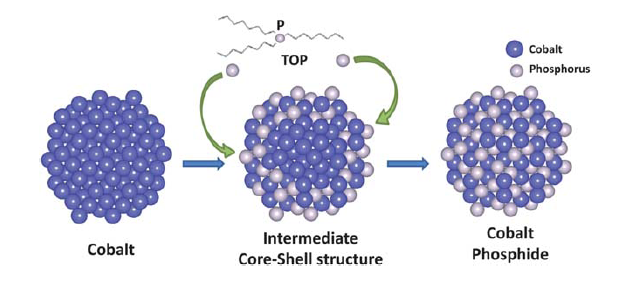
The evolutional schematics of transition from cobalt to cobalt phosphide nanocrystals (figure 1 from reference below).
The structural evolution and diffusion during the chemical transformation from cobalt to cobalt phosphide nanoparticles
Just as living systems have adapted by demonstrating a hierarchical organization of structure and function over many length scales, materials can display very different properties depending on their length scale. While bulk materials are generally well understood and characterization methods to study them are mature, materials on the nanoscale can display complex behavior due to the emergence of novel and non-bulk properties that result from their small size. As announced in “This week’s Hot Articles from Journal of Materials Chemistry” for May 6, 2011, knowledge about the structural rearrangements occurring during the chemical transformation of nanoparticles could help tailor the synthesis and composition of nanoparticles to improve their properties. A team led by Richard Robinson (Cornell University MS&E) reports the atomic and morphological structure of Cobalt nanoparticles as they are transformed into cobalt phosphide using x-ray absorption spectroscopy, XRD, TEM, and DFT calculations. (J. Mater. Chem., 2011, DOI:10.1039/C1JM10337G Advance Article)
Reference:
Don-Hyung Ha, Liane M. Moreau, Clive R. Bealing, Haitao Zhang, Richard G. Hennig, and Richard D. Robinson; “The Structural Evolution and Diffusion During the Chemical
Transformation from Cobalt to Cobalt Phosphide Nanoparticles,” J. Mater. Chem. April 15, 2011 (DOI: 10.1039/c1jm10337g)
Complete article (subscription may be required):
http://pubs.rsc.org/en/Content/ArticleLanding/2011/JM/C1JM10337G
__________________________________________________
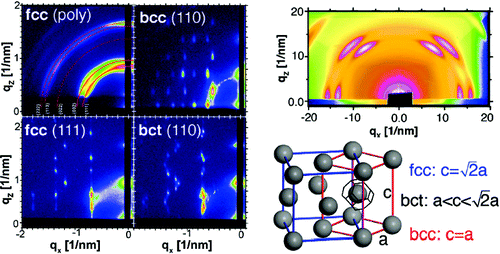
Controlling Crystallization in Nanocrystal Superlattices
There has been much recent excitement about the use of nanometer-sized crystals (NC) for a wide variety of applications ranging from optoelectronics to catalysis to biology and medicine. Nanocrystals are formed by an inorganic core, which can be a metal, and insulator, or, as in the case of lead sulfite (PbS), a semiconductor. Nanocrystals may be synthesized with a corona of organic molecules anchored on the nanocrystal surface. These so-called ligands, typically alkyl chains with a reactive headgroup for the anchoring, facilitate dissolving the nanocrystals in suitable solvents. This eases processibility, which is important for the wet-chemical fabrication of organic solar cells and many other applications.
Complete article:
http://news.chess.cornell.edu/articles/2011/Smilgies04282011.html
__________________________________________________
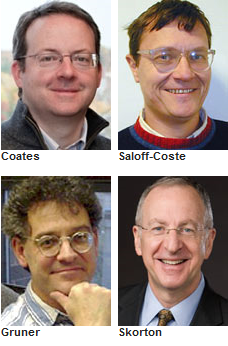
American Academy of Arts and Sciences
Congratulation to our director, Sol M. Gruner as a newly elected fellow of the American Academy of Arts and Sciences! Sol is among 212 newly elected members and will be inducted Oct. 1 in Cambridge, Mass.
Complete article:
http://www.news.cornell.edu/stories/April11/AAASfellows2011.html
__________________________________________________
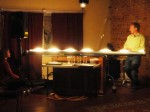
Science of Sound Cabaret
Have you spent many a restless night debating the improbable question; ‘If a tree falls in a forest and no one is around to hear it, does it make a sound?’ If so, and if you were one of the fifty people that attended the Science of Sound at Delilah’s Lounge Friday night, March 18th, located on South Cayuga Street in Ithaca, NY, you would have been able to put your mind at ease. Spectators at the CLASSE-sponsored outreach event witnessed how a sound wave travels from a sound source through the air to the sound receiver (the ear) much like the coils of a Slinky behave when fed through a pipe and pushed from one end.
Complete article:
http://news.chess.cornell.edu/articles/2011/HineSOS.html
__________________________________________________
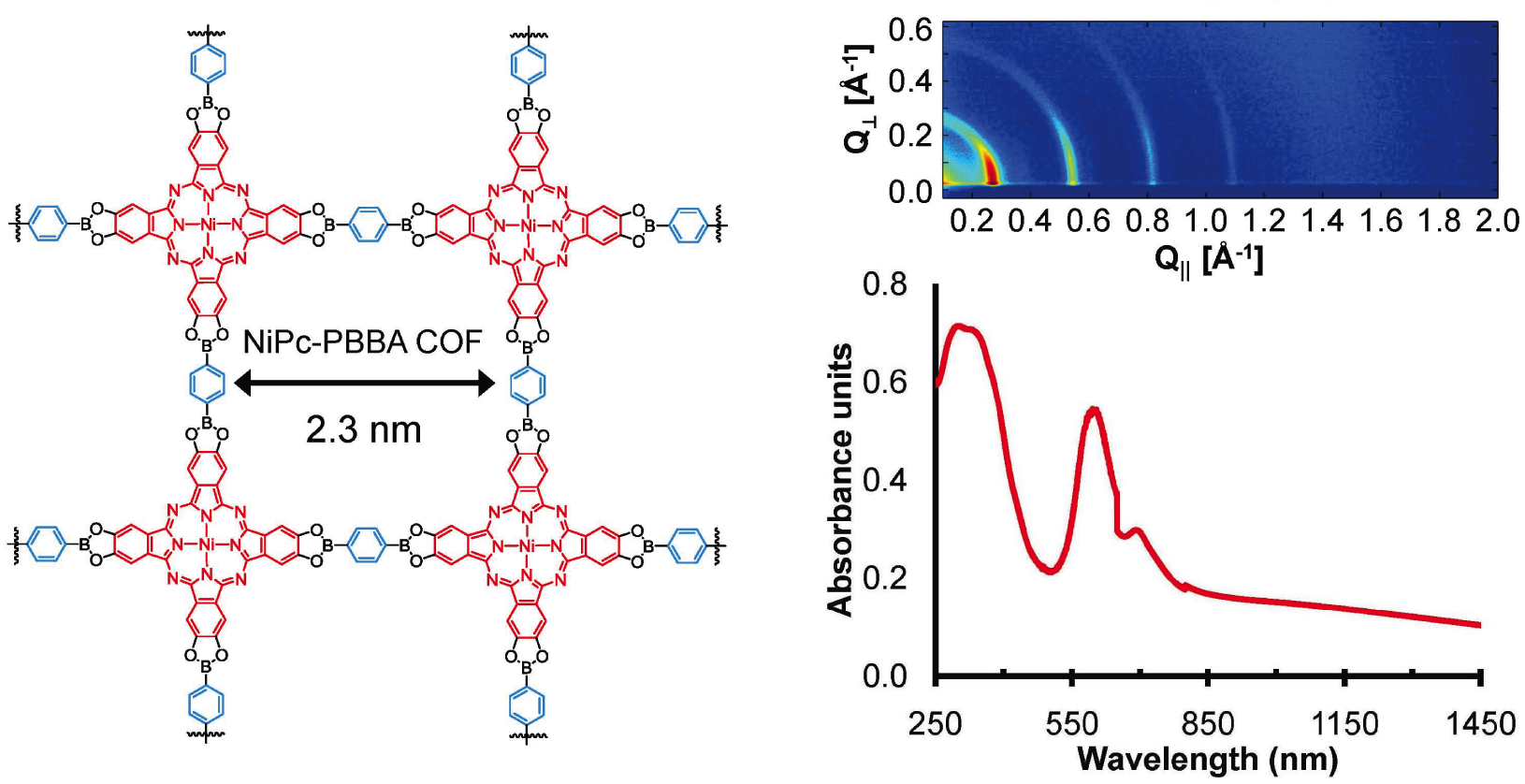
Organic Crystals Made to Order
Organic materials hold tremendous promise for inexpensive electronic and optoelectronic devices such as solar cells, but these applications require the challenging step of coaxing molecules into crystalline form. Covalent organic frameworks (COFs) are a general approach to overcoming this challenge, in which molecules are specifically designed to form predictable crystalline structures. However, until now, these structures could be synthesized only as powders -- randomly oriented crystallites of limited use for electronic applications.
Complete article:
http://news.chess.cornell.edu/articles/2011/WollOrganic.html
__________________________________________________
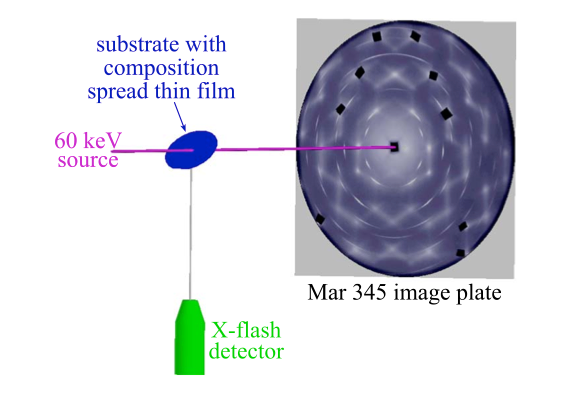
Novel Method Developed to Hunt for Fuel Cell Catalysts
A major challenge for developing next-generation fuel cells, which generate electricity by combining hydrogen and oxygen, is developing catalysts that are cheaper and longer-lasting alternatives to those based on platinum. A search for alternative catalyst materials among binary and ternary compounds is underway, but the variety of these compounds is virtually infinite. To make the problem more tractable, researchers at the Energy Materials Center at Cornell (EMC2) have developed a novel technique to screen thousands of potential catalyst materials in parallel.
Complete article:
http://news.chess.cornell.edu/articles/2011/emcc040511.html
__________________________________________________
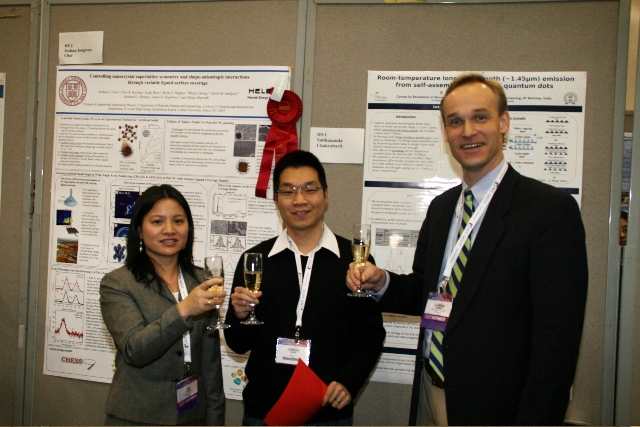
Nanocrystal Arrays for Optoelectronic and Other Applications
Crystals consist of atoms arranged into periodic arrays. There has been much recent excitement about the use of nanometer-sized crystals (NC) for a wide variety of applications ranging from optoelectronics to catalysis. Recent interest has centered on whether NCs of a uniform size can themselves be assembled into a periodic array, thereby creating a crystal of nanocrystals. These nanocrystal superlattice arrays would have interesting new optoelectronic properties that do not exist with individual NC particles. Thus, it is crucial to understand and ultimately control the mechanisms governing NC superlattice formation, in order to realize such optoelectronic applications. Scientists at Cornell University have now developed a novel way to controllably create nanocrystal superlattices.
Complete article:
http://news.chess.cornell.edu/articles/2011/Woll040511.html
__________________________________________________
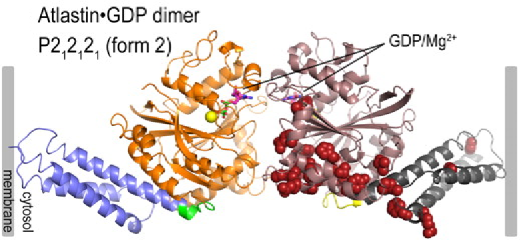
Grand Central Station
The endoplasmic reticulum (ER) has often been described as the Grand Central Station within the living cell. This complex network of membrane sacks and tubules surrounding the nucleus is a major crossroads for synthesis, folding, modification, and transport of many important biological molecules. How is this intricate membrane structure formed and maintained?
Complete article:
http://news.chess.cornell.edu/articles/2011/Gillilan032011.html
__________________________________________________
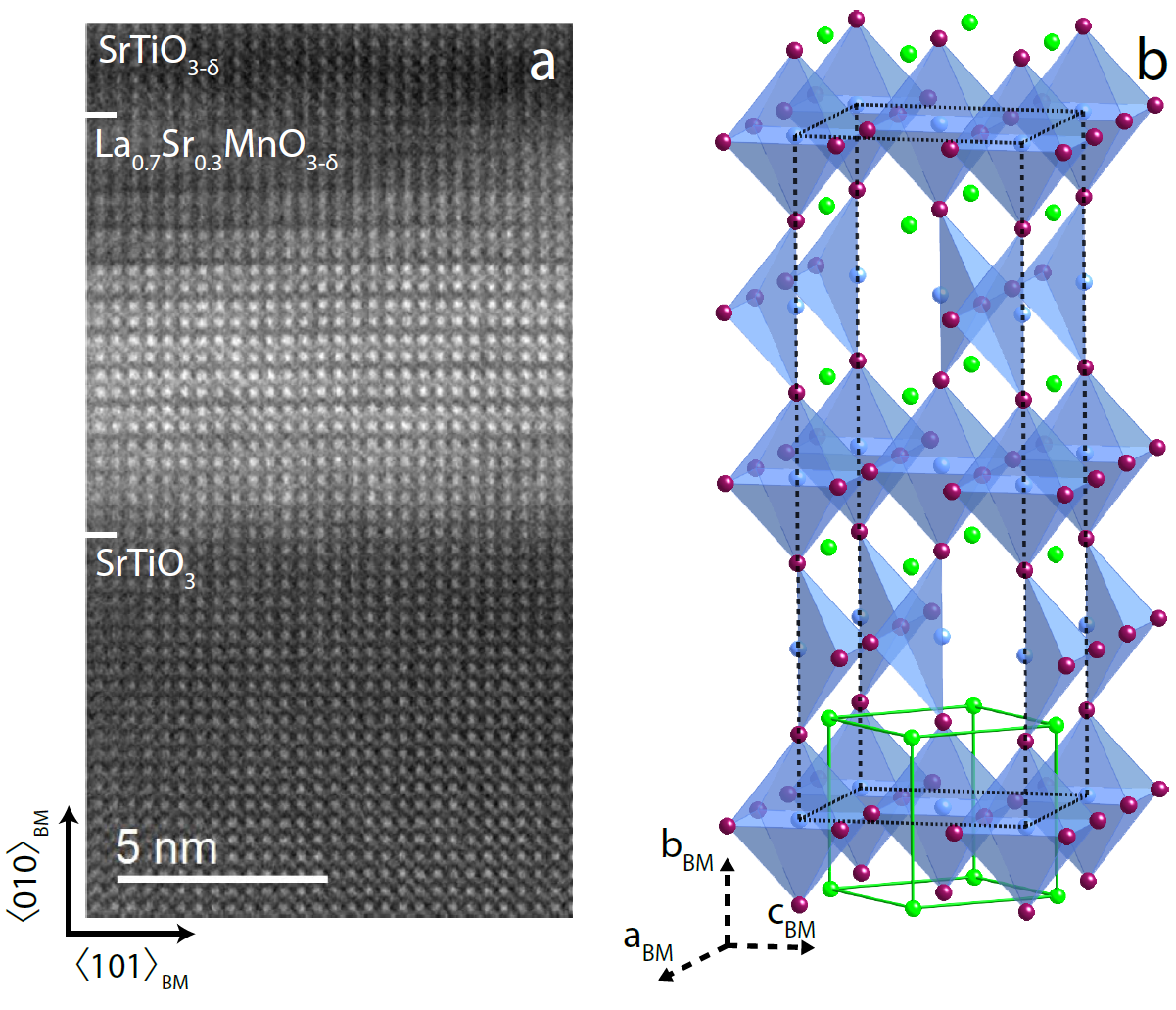
Novel Oxide Fuel Cell Materials
Among the many exciting potential applications of complex oxide materials are their use in solid oxide fuel cells, oxygen sensors, and other applications requiring oxygen anion diffusion. Some of these materials can form distinct, oxygen-deficient, ordered phases with high ionic conductivity, but fabricating such phases poses a challenge. Now, researchers at Cornell University and CHESS have discovered a new way to fabricate such materials using standard thin film deposition techniques.
Complete article:
http://news.chess.cornell.edu/articles/2011/Woll032011.html
__________________________________________________
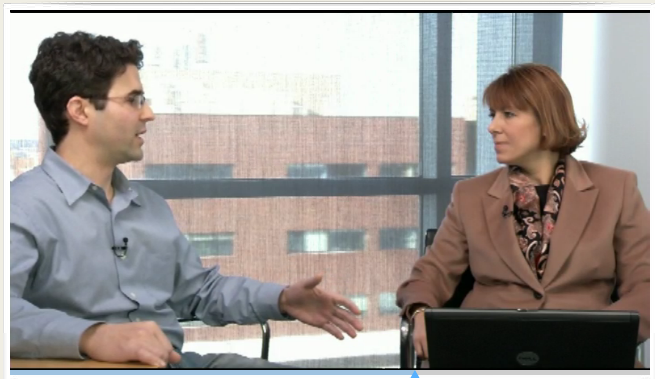
Staff Notes with Arthur Woll
Staff Scientists video interview explains importance of G-line as a student training center.
Complete article:
Staff
Notes: CHESS with Arthur Woll (CornellCast
collection)
or Download the MP4 file: (MP4)
______________________________________________
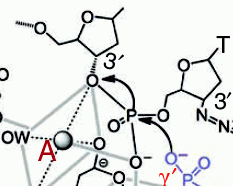
Mechanism of HIV drug resistance
Drugs which inhibit the activity of the reverse transcriptase of HIV-1 (HIV-RT) are effective in treating AIDS, since the virus cannot replicate without a working RT. Unfortunately, HIV is prone to mutations, some of which can render a formerly potent drug ineffective. The Arnold group (Rutgers) has now elucidated the mechanism by which a mutated form of HIV-RT resists the drug AZT.
Complete article:
http://news.chess.cornell.edu/articles/2011/Arnold.html
